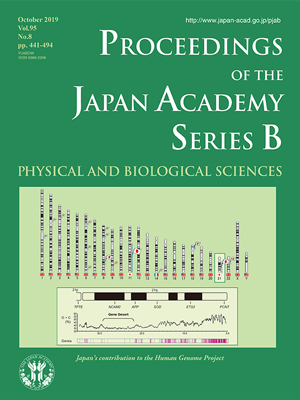About the Cover
Vol. 95 No. 8 (2019)
The Human Genome Project (HGP) was a historic achievement that decoded the entire human genome, our own genetic blueprint, and opened a new chapter in medicine and human life sciences. The project was conducted through an international cooperation, to which Japanese scientists made remarkable contributions from its inception to the final completion. The article by Yoshiyuki Sakaki (pp. 441-458) entitled “A Japanese history of the Human Genome Project” highlights several important contributions of Japanese scientists to this historic project.
From the viewpoint of technology, two especially important contributions were made. In the early 1980s, Akiyoshi Wada proposed and developed pioneering work for the automation of DNA sequencing technology, which made a major impact on leading scientists in the US and UK and stimulated their actions towards the HGP. In the mid-1990s, Hideki Kambara developed a key device for multi-capillary high-speed DNA sequencing, which brought dramatic changes in the HGP.
From the scientific viewpoint, Ken-ichi Matsubara exhibited exceptional leadership to launch and develop the comprehensive human genome program in Japan. In the program, the Japanese genome community successfully recruited young scientists and established a framework for genome sciences including genome informatics.
From the viewpoint of the international cooperation, the completion of sequencing of chromosome 21 (Chr.21) in 2000 was a symbolic achievement to show the presence of Japan to the international community. From the early stage of the HGP, Japan (and Germany) was considered as a non-major player because of its limited budget size. In such serious circumstances, Y. Sakaki proposed and organized an international consortium in 1994, sharply focusing on the analysis of the smallest Chr.21, in collaboration with German groups. Enthusiastic efforts by the Chr.21 consortium were rewarded in 1998 by establishment of the RIKEN Genomic Sciences Center (GSC), the Japanese flagship center for genomic sciences equipped with high-power DNA sequencing systems equivalent to those of five big genome centers in the US and UK. RIKEN GSC accelerated the completion of Chr.21 sequencing and analysis in a very short period of time.
In May 2000, the Chr.21 consortium published a paper on the completion of the human Chr.21 in Nature. The paper presented several interesting features of the human genome from the analysis of the Chr.21 sequence, such as the extremely uneven gene distribution on the chromosome (e.g., gene-poor regions called gene deserts), and the first estimation of the total number of human genes to be at most 40,000, which was much less than the 100,000 estimated before the HGP, from identification of 225 genes on Chr.21 of ~34 million base-pairs (Mb) (Later in 2004, a total of ~22,000 genes were identified in the finished human genome of ~2,900 Mb). Because the disclosure of the Chr.21 sequence had extremely high completeness and accuracy, this article was recognized as a gold standard for the later publication of papers on individual chromosomes. In addition to publication of the finished human genome by the HGP consortium in 2004, the publication of the 24 individual chromosomes was also finished in 2006, including a paper on the completion of the ~135 Mb chromosome 11 led by RIKEN GSC.
Masahira Hattori
Faculty of Science and Engineering, Waseda University Laboratory for Microbiome Sciences,
RIKEN Center for Integrative Medical Sciences




